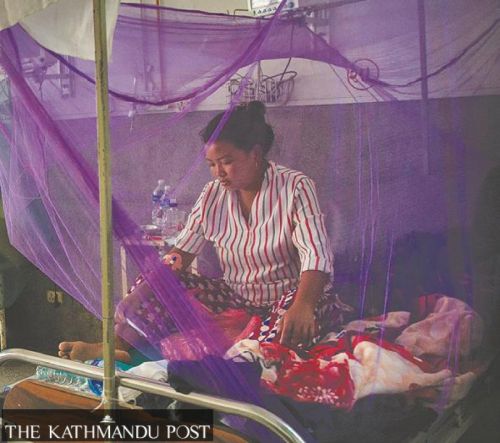
Dengue infections are assuming alarming proportions in Nepal.
Kathmandu reported the first case of dengue in May and a second one in June. By July-end, the caseload had increased to 35. The viral disease saw a marked surge in August, with over 700 infections reported in the month. The number has already crossed 1,000 this month – and we are not even halfway through September.
Despite this alarming rise in case-number, local authorities, especially the Kathmandu Metropolitan City, carried out a search-and-destroy drive only last week. Representatives from many other local units in Kathmandu have also said they have completed the operation.
Search-and-destroy campaigns are the most effective means to eliminate the breeding sites of mosquitoes, the vectors, and to raise awareness among the people to take precautions, said Basanta Adhikari, chief of the Health Office, Kathmandu.
“Local units are responsible for taking preventive measures including search-and-destroy drives,” Adhikari said. “But our officials apparently think they have completed their duty just by launching the drive.”
So far, around a dozen people have succumbed to dengue and more than 8,000 patients have been reported from across the country. The deadly virus has been detected every month since January. The viral disease has already become endemic to Nepal, public health experts say.
“Detection of infection throughout the year, cases being reported from almost all districts across the country and the presence of vector in all districts mean dengue virus has become endemic in Nepal,” said Dr Meghnath Dhimal, an expert member of the World Health Organisation-South East Asia Regional Expert Group on Environmental Determinants of Health and Climate Change.
An epidemic is an outbreak of disease that affects a large number of people within a community, population or region, experts say.
Delay in taking preventive measures such as launching a dengue search-and-destroy drive means the infection rate could increase exponentially in the coming days, Dhimal added.
“If we had taken preventive measures immediately after the first cases were detected, the deadly disease might not have spread all over the country and so many people would not have been infected,” Dhimal said.
Dengue is a mosquito-borne disease transmitted by female Aedes aegypti and Aedes albopictus mosquitoes. The same vector also transmits chikungunya, yellow fever, and Zika viruses, according to the World Health Organisation.
Although the post-monsoon period is considered a high transmission season for dengue, Nepal has witnessed outbreaks of the deadly disease since the beginning of the year and in the pre-monsoon, monsoon, and post-monsoon seasons.
Experts say reported cases of dengue could be just the tip of the iceberg, as around 90 percent of the infected people do not show any symptoms.
“Asymptomatic people can easily spread the disease through the vectors [disease-carrying mosquitoes],” said Dr Baburam Marasini, former director at the Epidemiology and Disease Control Division.
“Cases of infection are being reported from all over the country and no effective measures are being taken,” he added. “This means we are unprepared to deal with a dengue epidemic.”
The epidemic is going to be all the more worse with underdeveloped countries like Nepal coping with the worst of climate change impact.
A recent report published by the United Nations—‘Climate Change 2022: Impacts, Adaptation and Vulnerability’—states that at least six major vector-borne diseases affected by the climate drivers have recently emerged in Nepal and are now considered endemic.
The report also shows increasing evidence that global warming has extended the elevational distribution of Anopheles, Culex, and Aedes mosquito vectors above 2,000 metres in Nepal. Of about 460 species of Anopheles, over 100 transmit malaria, another mosquito-borne disease. Over 950 species of Aedes spread dengue, chikungunya, Zika, yellow fever, and the West Nile virus.
Doctors warn the lethargic approach of agencies to controlling dengue’s spread could be costly.
“The ongoing dengue epidemic shows that we learned nothing from the Covid-19 pandemic,” said Dr Keshab Deuba, a public health epidemiologist. “Had we learned something, we could have easily prevented the spread of dengue infection.”
Doctors also blame multiple agencies of the three tiers of government—federal, provincial, and local—for the unchecked increase in dengue cases. The agencies do little more than pass instructions and are indirectly responsible for the rampant spread of the deadly virus in the country, they say.
“We lack agencies that assume responsibility and take timely preventive measures,” said Dr Prabhat Adhikari, an infectious disease expert.
According to doctors, mild to high fever, severe muscle pain, rashes, severe headache, and pain in the eyes are some of the symptoms of dengue.
In 2019, at least six people had died and over 17,000 were hospitalised with dengue fever. The outbreak, which had started in the pre-monsoon period from Dharan, spread to 68 districts.
The UN health agency says there is no specific treatment for severe dengue, but early detection and access to proper medical care can lower the fatality rate.












